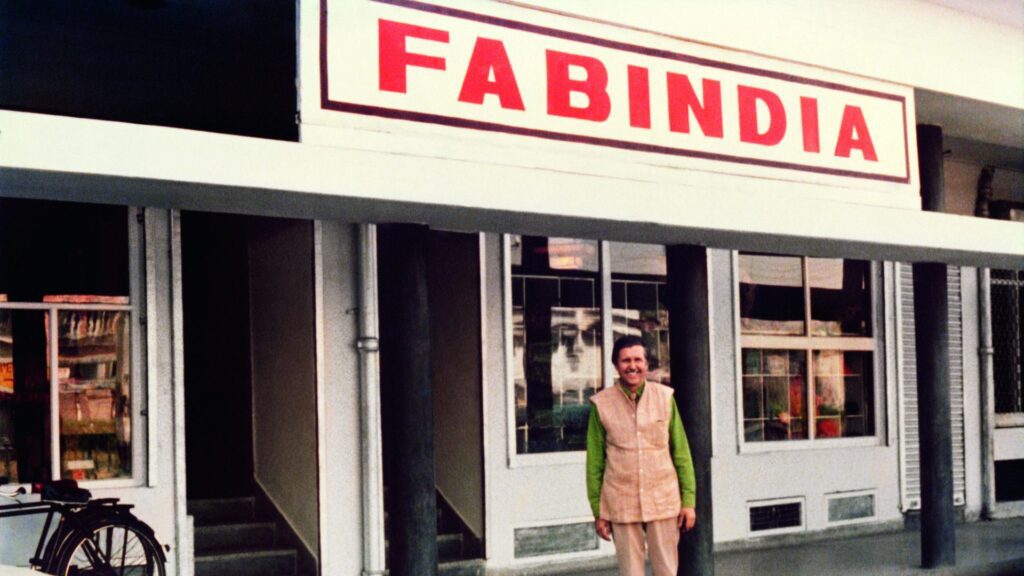Fabindia – India with a Contemporary Touch

Fab India serves out the most exquisite shapes and styles by fusing local ethnic motifs with a contemporary touch.
John Bissel had Hartford roots; his grandfather was the President of Hartford Fire & Life Insurance Company. John attended the Brooks School in North Andover and then graduated from Yale.
John had listened to his father’s wartime tales (WWII) of India since he was a little boy. His feelings for India developed in tandem with this.
John started working as a buyer for Macy’s in New York after finishing college; at about the same time, he acquired an appreciation for the aesthetics of hand-woven textiles.
John’s two passions came to fruition in 1958 when he was awarded a two-year grant by the Ford Foundation to work with the Central Cottage Industries Corporation, which the Government of India established to produce items for export.
He was confident that the Indian textile sector was primed for explosive expansion. He set out to aid the country’s venerable handloom textile industry by discovering new avenues for its skilled craftsmen.
During this time, he met Bimla Nanda, the Social Secretary for the then-Ambassadors to India for the United States, Chester A. Bowles and John Kenneth Galbraith.
John intended to marry Bimla, remain in India once his grant ended, and start a new life there. And thus, a new era in his life had begun!
Without a doubt, he was sure that the Indian handloom textiles were phenomenally successful and only needed a stage. After seeing the problem and the potential profit, he founded Fabindia in 1960 to implement his plan.
The first funding for the business came from the $20,000 he inherited from his grandmother. In the past, it was housed in two adjoining bedrooms in his Golf Links apartment. Fabindia Inc. was also the name under which it was established as a legal business in the town of Canton, Connecticut.
When he set out to build the firm, he had two primary goals: to combine the most significant features of East-West cooperation and to create a fair and impartial workplace for these craftsmen and traditional artisans.
The original Fabindia was John working alone to export furnishings. He had the notion back then of exporting India’s crafts to the rest of the globe.
John crisscrossed the country, visiting craft centres and small towns in search of weavers and business owners who could make handloom fabric with a flat weave, light colours, and accurate weights. After a lengthy search, he found the ideal partner in Panipat-based dhurrie and home furnishings company A. S. Khera.
John met British designer Terence Conran in 1964; Conran had just launched a furniture store chain named Habitat.
Things progressed to the point that Habitat became one of their most important clients. Furthermore, John set up a distribution network in the US to provide their wares to mom-and-pop shops around the country.
In 1965, the company’s revenue had surpassed Rs. 20 lakhs, and he had to transfer it out of his home and into an actual building.
As time went on, however, several changes were implemented inside the business. The firm had to deal with its fair share of challenges, but it always managed to transform them into opportunities for expansion.
New regulations were established by the government in 1975–1976, during the height of the Emergency Period imposed by then–Prime Minister Indira Gandhi. To comply with the rules, Fabindia had to vacate their second location, a home on Mathura Road, where they had been doing business.
While first concerning, this ultimately proved to be a blessing. John utilised this dilemma as an opportunity, creating their first Fabindia retail shop to sell their items in New Delhi and using it as their registered office.

To differentiate itself from other state-owned and state-subsidised competitors in the handloom textiles and clothing markets, Fabindia adapted its textiles and patterns to urban tastes.
Designers were tasked with updating the company’s home linens collection while simultaneously debuting a line of ready-to-wear items, including churidar-kurta sets for ladies and shirts for men.
However, this did not imply that they just outsourced production to village-based artists or craftsmen; to this day, the company’s design staff still provides the majority of the patterns and colours that these artisans then carry out.
Because of this, the conventional clothing and goods market saw a surge in popularity. It was immediately adopted by the expanding middle class, gaining a reputation as a symbol of sophistication while being accessible to a wide range of ethnic consumers.
At the same time that the Reserve Bank of India had mandated that all foreign firms keep their ownership stake at no more than 40%, Fabindia made a brilliant move by issuing new shares to friends, family, and business partners.
Since then, the company’s exporting and retail operations have been very successful. The corporation also expanded its storefront presence throughout this period.
However, in 1992, the firm was dealt yet another blow when Habitat, a significant client located in the United Kingdom, chose to end its business relationship with them. The reason behind this is that, after acquiring Habitat, the renowned Ikano group—the original creators of Ikea—decided to establish their purchasing arm in India.
And then, in 1993, just as they were beginning to get over it, John had a heart attack.
What Came Next
With John in his current state, it only made sense to invite his son William to join the business.
William, an undergraduate at Wesleyan University with a triple major in philosophy, politics, and government, had been helping to establish cooperatives for weavers and other craftsmen in rural areas of Rajasthan. After finishing college in 1988, he moved to Jodhpur and stayed there for some time.
William took over the business and continued working under his father’s tutelage till John passed away. The passing of John Bissell left behind a legacy and the benefit of his years of experience and expertise.
And ever since then, William has been running the company.
The Next Generation Takes Over
The firm was in profit and recording a turnover of Rs. 12 crores.
While John treated Fabindia more as a pastime, William took it very seriously. As CEO, William’s first order of business was to refocus the company’s efforts on the home market and transform it into a retail chain. Until then, most of the firm’s revenue came from outside since it only had two outlets in Delhi.
That was a turning point for the firm; they haven’t looked back since. Over the subsequent two decades, the firm underwent significant change, eventually evolving into its current iteration and surpassing its export business in the process.
As of 2006, Fabindia also sold a line of non-textile goods, first with organic foods, then cosmetics, and finally handcrafted jewellery.
They also launched a massive retail expansion, with additional and more prominent locations in major cities like Mumbai, Chennai, Delhi, and beyond.
It dawned on William that the village craftsmen were only receiving 5% of the retail price of their wares; the rest went to the middlemen. So, he established a system of artisan shareholders by forming “supply-region firms” as subsidiaries.
Inclusive Capitalism
A term coined by Fabindia, “Inclusive Capitalism.” Within this framework, local craftspeople may invest as little as $8 in the system’s localised enterprises and participate in the earnings. You may use the stock as collateral for a loan.
This strategy has been so successful that there are now eighteen such firms in operation throughout the nation, and more than forty thousand rural residents have invested in these businesses. Using this structure, Artisans own 26% of the company, Micro Finance, a Fabindia subsidiary, owns 49%, and workers and other investors hold the remaining 4%.
Fabindia has since gone from strength to strength.



